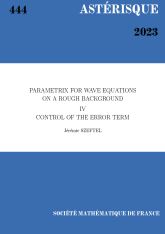Dynamique des fonctions rationnelles sur des corps locaux
Dynamics of rational functions on local fields
- Consulter un extrait
- Année : 2003
- Tome : 287
- Format : Électronique
- Langue de l'ouvrage :
Français - Class. Math. : 32H50, 37F10, 14G20, 39B12
- Pages : 147-230
- DOI : 10.24033/ast.595
Soit $p > 1$ un nombre premier, $\mathbb {Q}_p$ le corps des nombres $p$-adiques et soit $\mathbb {C}_p$ la plus petite extension complète et algébriquement close de $\mathbb {Q}_p$. Ce travail est consacré à l'étude de la dynamique des fonctions rationnelles sur la droite projective $\mathbb {P}(\mathbb {C}_p)$. À chaque fonction rationnelle $R \in \mathbb {C}_p(z)$ on associe son domaine de quasi-périodicité, qui est égal à l'intérieur de l'ensemble des points dans $\mathbb {P}(\mathbb {C}_p)$ qui sont récurrents par $R$. On donne plusieurs caractérisations du domaine de quasi-périodicité et on décrit sa dynamique locale et globale. On montre que les composantes du domaine de quasi-périodicité (qui sont les analogues $p$-adiques des disques des Siegel et des anneaux de Herman) sont des affinoïdes ouverts (c'est-à-dire que leur géométrie est simple) et on décrit la dynamique sur une composante donnée. Comme dans le cas complexe on a une partition de la droite $\mathbb {P}(\mathbb {C}_p)$ en l'ensemble de Fatou et l'ensemble de Julia. Par analogie au cas complexe on fait la conjecture de non-errance suivante : tout disque errant est attiré par un cycle attractif. On montre que ceci a lieu si et seulement si tout point dans l'ensemble de Fatou est soit attiré par un cycle attractif, soit rencontre le domaine de quasi-périodicité par itération positive.


